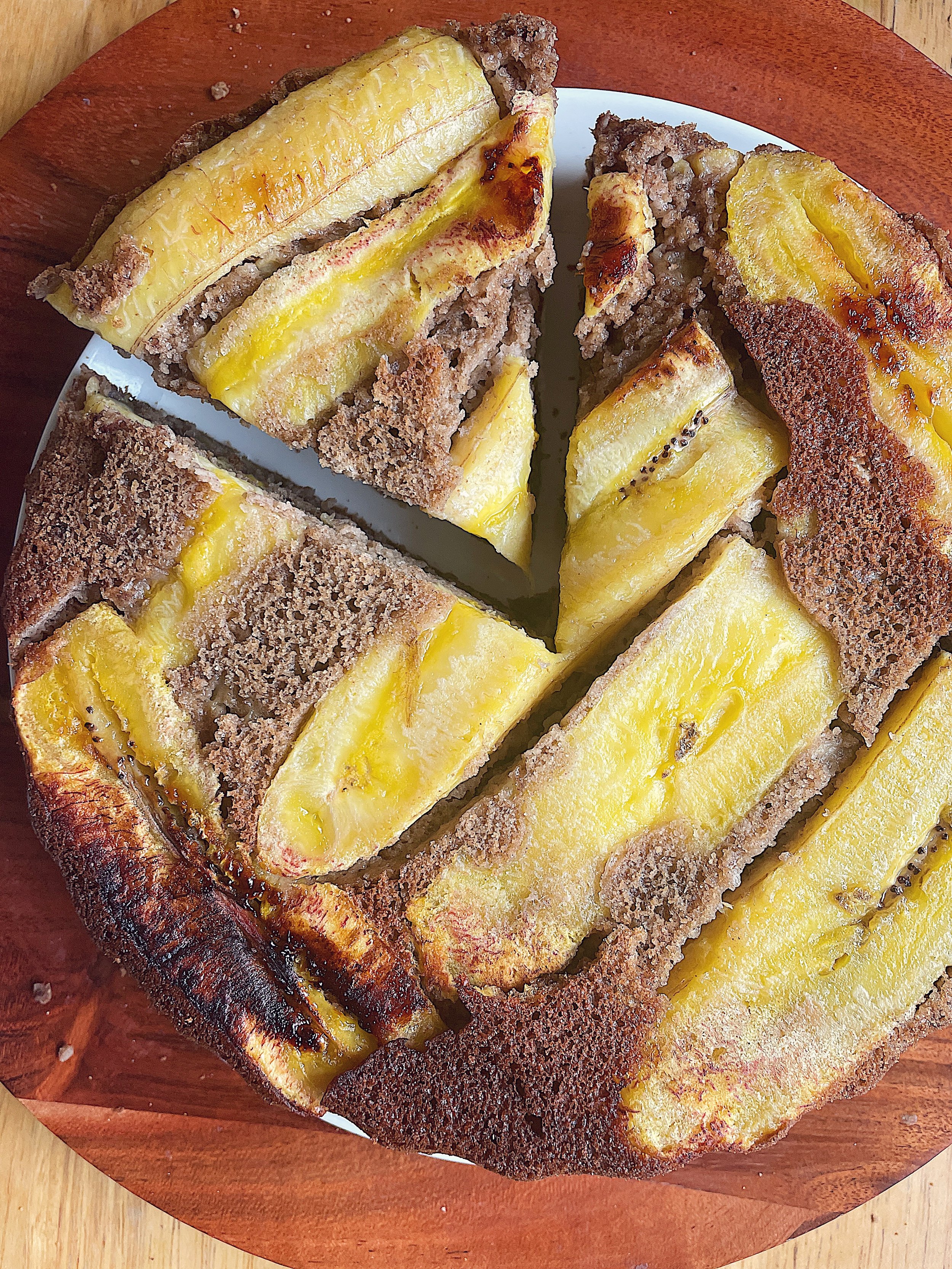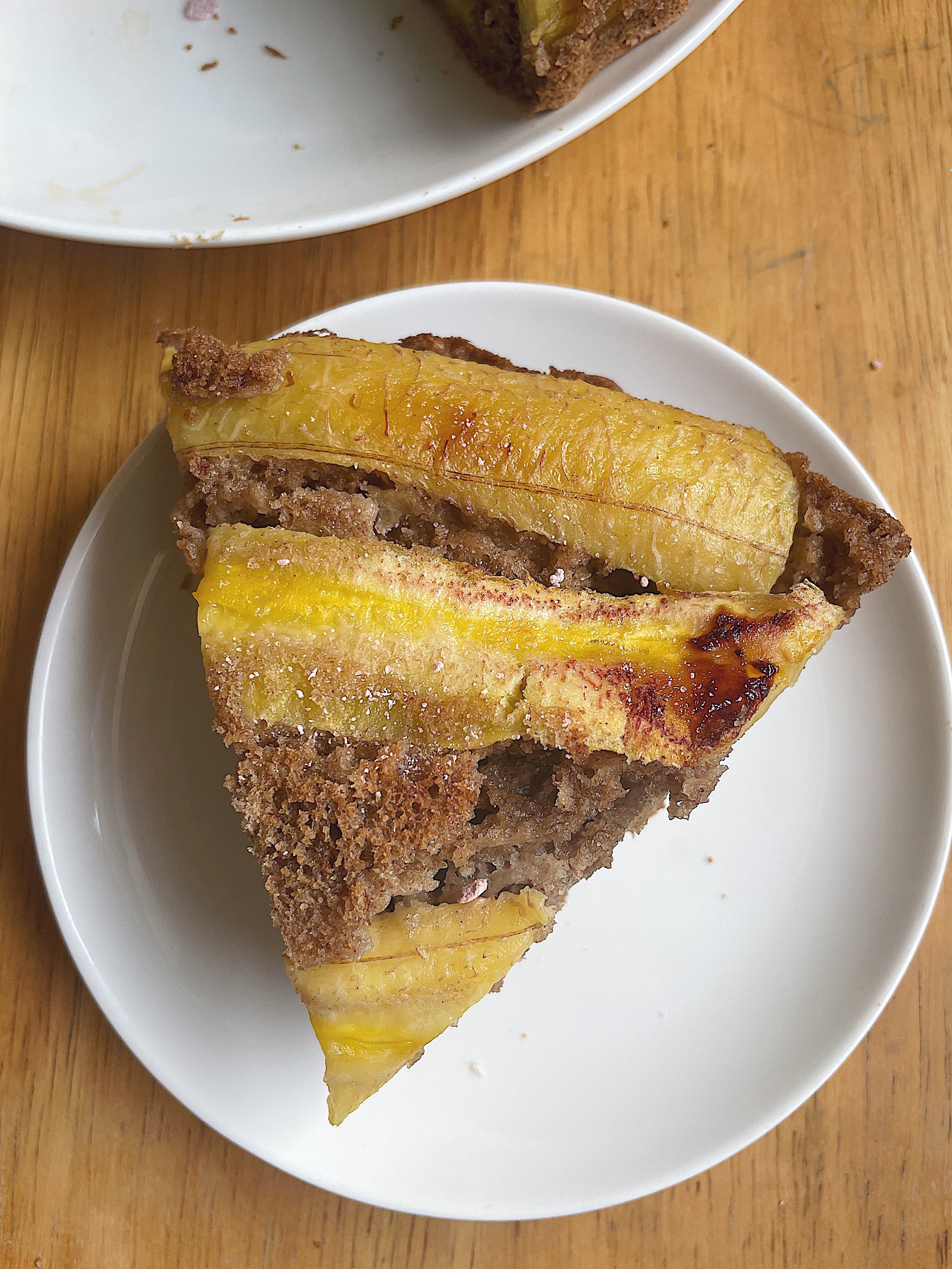Plantain Upside Down Cake
I don’t know about you, but I eat bananas and plantains year round. By late summer, as mid August begins to bend into fall I find myself reaching for plantains more and more. Perhaps it’s my internal clock telling me summers end is nearing and I need to prepare for the coolness of autumn and all those starchier root vegetables that are so similar to plantains in some ways.
A bit of plantain history
Plantains are similar to bananas but have a consistency that is more dense and starchy. They are native to Southeast Asia and spread to the Caribbean from Papua New Guinea and Malaysia between the 5,000-8,000 B.C.
Unlike bananas, plantains are usually not eaten in their raw form but are cooked prior to consumption. Dishes such as tostones are made with unripe green plantains while pan fried ripe plantains make the juiciest little sweet bites that pair deliciously with both meat and fish.
This plantain upside down cake is a fantastic sugar free and allergen friendly cake to have for breakfast with your favorite sides, proteins and fruit.
Ingredients:
Almond Flour: Almond flour is made from blanched almonds that are ground into a fine flour. I use almond flour and Tigernut flour interchangeably in many recipes. Tigernut flour has a richer flavor while almond flour holds together better in some recipes than Tigernut.
Tigernut flour: Tigernuts are not actually nuts at all but small tuberous vegetables that are grown similarly to potatoes. They have a sweet, nutty taste and have a number of nutrient dense health benefits. Most importantly, they are 100% anti-inflammatory. I would best describe the tigernut as a fantastic replacement for almond flour. Whereas almond flour can be a source of inflammation for many folks, tigernuts have no known inflammatory markers making them a safe and delicious flour to consume
Cassava: Cassava is native to Brazil and South America. It’s similar in shape to a sweet potato but is longer and brown on the outside. Inside the flesh is white. Like sweet potatoes and yams, cassava is also a tuber that is often made into a flour or is eaten on it’s own just like a potato. This root vegetable can be use as a substitute for many potato based recipes. It’s flour may also act as a 1:1 flour replace in some recipes as well.
Tapioca starch: Tapioca starch comes from the cassava plant and is the starch of the cassava root.
Arrowroot starch: Arrowroot is native to Guyana, Eastern Brazil, Southeast Asia, Australia and South Africa. Once this tuberous vegetable begins to become starchy, it is harvested, dried and powdered.
Coconut: Coconut flour comes from the flesh of the coconut. It is then dried and powdered. One of my favorite things about coconut flour is that it can be eaten raw! If you don’t like the taste of coconut flour or milk, I assure you it is just because your taste buds have not gotten used to it yet.
Eggs & Gelatin: If you are allergic to eggs, you may use gelatin as a substitute instead. Gelatin is the safest alternative for folks with allergies and gut health issues. I recommend using bovine gelatin to replace your egg. See notes below for how to make it
Substitutions (w/ links to purchase):
Almond flour: If you’re allergic to nuts or avoiding almonds while on the autoimmune protocol, you can substitute Tigernut flour in many recipes as a 1:1 sub. I usually purchase my almond flour from Trader Joe’s or Anthony’s on Amazon.
Tigernut flour: If you don’t have access to tigernut flour, you may use almond flour instead. It has a similar texture but comes from the almond nut whereas tigernuts are not a nut at all but a tuber. I use the gemini brand of tigernut flour which can be purchased at whole foods or on amazon.
Green Banana flour: Green Banana flour is made from unripe green bananas that are dehydrated and then grounding into a flour. If you cannot find it, you may substitute with plantain flour which has a similar consistency.
Plantain flour: Plantain flour is made from unripe green plantains, is dehydrated and then ground into a flour. If you can’t find any, a good substitute is green banana flour which is made in the same way.
Cassava flour: Cassava flour is a fantastic anti-inflammatory plant to use. You may try substituting with tapioca flour which is derived from the cassava root. Or, you may try almond flour as well.
Arrowroot flour & Tapioca Starch: These are basically interchangeable in most of my recipes. When indicated, you may swap one out for the other. I purchase these either from almost any grocery store - HMart, 99 Ranch, Whole foods, etc and also on amazon.
Coconut milk: I use a lot of coconut products. And a number of brands and really like the Native Forrest Brand which has a coconut milk that is free from all guar gums, If you are allergic to coconut milk, I recommend trying almond or cashew milk. Alternatively, you may try making your own nut milk using tigernut flour or making some banana milk with banana and some water.
Gelatin Egg:
To make your gelatin egg, bring a small amount of water to a boil. Add 2 tbsp boiling water and 1 tbsp room temperature to a small dish. Then slowly pour in 1 scoop or 10g of bovine gelatin to the mixture. As you pour, stir with a spoon or chopstick to ensure you get a smooth blend. Pour this mixture directly into your bake. It will harden as you continue working.
Plantain Upside Down Cake Recipe
Ingredients:
Wet
1 ripe banana (sub 1/4 cup sweet potato or 1/4 cup pureed squash
1 egg (sub gelatin egg. see notes above)
1 + 1/2 cup coconut milk
2 tbsp avocado oil
165g apple sauce
Dry1/2 cup cassava flour
1/2 cup green banana flour
1/2 cup tapioca flour
3/4 cup almond flour
Cinnamon, to taste
Pinch of salt
1 tsp baking soda
2 yellow, semi-spotty plantains
Preparations:
Preheat your oven to 350F.
Prepare your ingredients first. Peel both plantains. Dice one into small bite sized pieces and slice the second one length wise. We'll be adding the first plantain to our batter later. Oil a pie dish with coconut oil or avocado oil. Then, lay the long plantain slices down into your pie dish.
Mash your ripe banana in a large bowl until smooth. Beat in 1 egg. You may also use a gelatin egg. If using a gelatin egg, add it in right before stirring in your bite sized plantain pieces. Pour in 2 tbsp avocado oil, 1 1/2 cups of full fat coconut milk and the apple sauce. Whisk until smooth.
In a separate bowl combine the cassava flour, banana flour, tapioca flour, almond flour, baking soda and cinnamon. Mix this batter into your wet ingredients and stir until combined. Immediately prepare and add in your gelatin egg if using (see notes above for how to make it). Then, gently stir in the plantain pieces you set aside earlier.
Transfer this mixture into your oiled pie dish with the plantains in it. Bake for 45 minutes at 350F or until a toothpick comes out clean.
Remove this from the oven and let it cool completely before attempting to flip it over. Once it's cooled, loosen the sides with a butter knife and turn it upside down. Consume immediately or store it in the fridge for up to five days.





